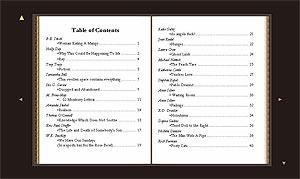Q3. What's the actual/virtual place of digital literary media?
Digital Literary Media Defined

Coe Review's issue-within-a-web-page table of
contents. Interactive arrows are used to move
between pages.
Digital literary media, as a genre of publication, has grown considerably in the last few years. In its most basic form, digital literary media = literature available in a digital (i.e., electronic, and for all intensive purposes = online) format.
At one end of the spectrum lie online journals that are simply internet-based versions of print journals, offered either in HTML or PDF formats. Elsewhere: A Journal for the Literature of Place is one example — with an HTML interface, each issue is a PDF that may be read online or downloaded/printed to read offline. Or check out the Coe Review for an interesting (though still static; perhaps forever static since the "current issue" dates back to 2005) presentation of print within an HTML wrapper.
At the other end of the spectrum lie journals and delivery mechanisms that go far beyond online print. I think of Born Magazine — "an experimental venue marrying literary arts and interactive media," usually in a Flash-based format —; Shape of a Box, YouTube's first literary journal, which means it's the first all-video literary journal, as far as I can tell; and Rabbit Light Movies, a biannual journal of poemfilms.
What about television and film? Surely good documentary, for example, has as much literary merit, longevity, and power as traditional literature. Yes, but my focus is on internet-based journals and tools, which with increased bandwidth can deliver television shows and movies, as well as videos, podcasts, and other interactive features.
Which makes me think: What's the future hold?

